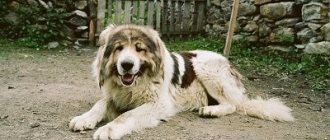German Shepherd puppies are cute and friendly animals. After birth, they have to go through difficult stages of growing up. This article will discuss one of the stages of development of puppies in the first month of their life. The weight and height of the dogs at this time will be reviewed, as well as their conformation. In addition, detailed information will be provided on the diet, care and maintenance of tailed friends.
What does it look like
After the birth of the puppy, it is difficult to understand what appearance the pet will have.
His exterior characteristics appear only in the third or fourth week after birth. At one month of life, a shepherd puppy looks something like this:
- Wide, barrel-shaped chest, flat and short back.
- The limbs are voluminous and long, there is no big toe above the foot.
- Boys are always larger than girls and weigh up to 4.2 kilograms, girls up to 3.5 kilograms.
- The eyes are almond-shaped and usually have a brown tint, but some can have blue eyes for up to two months.
- The head is proportional to the body, the forehead protrudes strongly, the nose is black and large, and a small hump may be visible on the bridge of the nose.
- Milk teeth appear on the 20th day of life (a total of 32 teeth before six months). Scissor bite.
- The ears are soft and drooping. This situation lasts up to 6 months of the dog’s life.
- The coat is hard with a dense undercoat.
- The color is black, sometimes with small red spots.
It is worth remembering that a newly born puppy's eyes are closed. They open 10 days to two weeks after birth. In addition, all newborn puppies do not hear any sounds until 3-4 days after birth and do not have teeth.
Period from birth to three weeks.
One should not think that puppies, while they are blind, are meaningless toys. A newborn puppy, as soon as he has taken a breath of air and adjusted his breathing, moves independently and finds the nipple. Even being blind and deaf, they can smell and feel warmth. Of course, during this period they are completely dependent on their mother - a source of warmth and food.
Puppies should approximately double their weight in the first week of life. Already on the second day after birth, the puppy becomes dense and elastic to the touch, its coat is smooth and clean. He sucks, pulling back the nipple and pressing his paws on the mammary gland. Puppies actively seek out nipples and may push each other away. By the end of the first week of life, the puppies weigh approximately the same; but, if there is a small and weak puppy in the litter, you need to make sure that it is not pushed away by stronger ones, and always put it close to the nipples. A puppy that doesn't suckle likely won't survive, no matter how hard you try to feed it. Often the mother dog itself pushes away weak and non-viable puppies. For the first two weeks, the mother takes full care of the puppies; you just need to make sure that she doesn’t accidentally run over them and that she has enough food herself. The dog cleans the nest itself by eating the puppies' excretions. It is necessary to periodically change the litter so that it is always clean. The room where the puppies are kept should have a constant temperature (about 23 °C) and no drafts. Starting from the seventh day, the temperature can be lowered slightly. If the mother dog is not constantly in the nest, the puppies can be placed on an electric heating pad or warmed with an infrared lamp. At 12-14 days, puppies begin to see and hear. They are already growing baby teeth. By this time, puppies of some breeds are already standing on their paws and trying to walk (puppies of heavy dog breeds - bloodhounds, mastiffs - begin to walk later). By this time, it would be good to make a special enclosure for the puppies so that they do not wander around the entire apartment. As soon as the puppies begin to move independently, they crawl out of the nest to empty their bowels. Therefore, you can put a soft faux fur bedding in the nest (the puppies won’t get it dirty). The floor in the enclosure is usually covered with newspapers, which makes puddles and piles easier to clean up. A puppy accustomed to newspapers will be easier to train to go to the toilet in a certain place. The floor, of course, must be waterproof (for example, linoleum); it must be wiped with some kind of disinfectant solution once every two days. As soon as the puppies open their eyes and their teeth appear (14-15 days), they can begin to be fed. Now you can buy special porridge for puppies at the pet store. If puppies are weak or their digestion is often upset, it is better to start complementary feeding with a special porridge. Strong, robust puppies can be given meat. Usually they make a “scraper”: frozen meat is thinly sliced, then separated into fibers, defrosted and rolled into balls approximately the size of a pea. Each ball is lightly moistened with vegetable oil and placed in the puppy’s mouth. If the puppies feel well after the first feeding, they can be fed meat first once and then twice a day. In addition to meat, puppies are fed calcined cottage cheese, which is made from milk: add 3-4 tablespoons of calcium chloride to 1 liter of milk and heat the mixture until the milk curdles. Then the whey is drained (it can be given to the dog), the cottage cheese is mixed with milk and given to the puppies. Food for small puppies should be heated to approximately 35 5C: food that is too cold can cause stomach upset, and food that is too hot will burn the mucous membrane of the mouth and esophagus. Puppies can be given various milk porridges (for example, from rolled oats or wheat flakes), but it is better to feed them with ready-made food for puppies (Ekanuba Pappy, Pedigree Advance Junior-1 and others). The food is soaked overnight in boiled water, broth or milk, it swells and is given to the puppies in this form. Ready-made food contains much more nutrients than regular cereals and is rich in all essential vitamins and minerals. Puppies, especially large breeds, will have a more marketable appearance by two months if they are fed with ready-made food. From the very beginning, puppies should be taught to eat from a bowl, and not from a nipple. The first portions of new food are placed directly into the puppies' mouths. Okies very quickly understand what is required of them and begin to eat. Small puppies are not given separate bowls - all the puppies will climb into one of them anyway. Typically, for a litter of seven puppies, three large deep plates or low bowls with heavy bottoms are placed (so that the puppies cannot tip them over). The puppies will run from one bowl to another, getting into them whole, but in the end they will all eat. Ready-made food is given to puppies according to the instructions (a certain amount of food per kilogram of weight of the puppy), so much porridge should be given so that after feeding some of it remains in the bowls.
From three weeks to two months.
By three weeks of age, puppies can be fed two to three times a day. At the age of three weeks to two months, puppies should be gradually weaned from suckling their mother and transferred to regular food. Puppies should always have access to clean drinking water. Despite the fact that puppies receive protection from infections from their mother's colostrum, during this period of their life the risk of disease is quite high. First of all, infection with worms is dangerous. The first time an anthelmintic is given at the age of 21 days (it is better to give special veterinary drugs intended for puppies). If you suspect that the anthelmintic medicine has not worked, you can take the puppies' feces to a veterinary laboratory for parasitological testing. If you are infected with fleas, you can; Use only special medications intended for puppies. * Symptoms and treatment of infectious diseases - colibacillosis, salmonellosis, viral infections were described in the section “When a dog gets sick”. Most mother dogs take good care of their puppies by licking them, and you don't need to help her do this. However, some dogs place the responsibility of caring for their puppies on their owner. In this case, you will need to make sure that the puppies are clean, wipe the anus, ears and eyes with a clean napkin. At this age, puppies need to have their nails trimmed weekly to prevent them from damaging the mother's mammary glands. The older the puppies get, the more often their mother leaves them. During the period of weaning from mother's milk, you need to prepare a place for the dog that would be inaccessible to puppies and where she could rest from her “little tormentors.” The number of milk feedings (when puppies suckle from their mother) should be gradually reduced, starting at 3-4 weeks of age. By the age of two months, puppies should already be fully fed with food and not suckle from their mother. By this age, the bitch’s milk disappears. At the age of 40 days, purebred puppies are usually examined by a specialist from the kennel club and, if the puppies meet the standard, they are issued with the documents necessary for sale (puppy card). This procedure is called activation. By this point, the puppies must have gained a certain weight (for example, a German Shepherd puppy must weigh at least 4 kg, a collie puppy - at least three)
Natural or dry food
Around the end of the first month of life, when the puppies' suckling period ends, you can slowly begin to feed your German Shepherd puppies adult food. Complementary foods can be natural or dry. Owners use dry complementary foods if they do not have time to prepare natural food.
Typically, this is a special food for puppies, formulated to meet their needs for vitamins and minerals, as well as proteins, fats and carbohydrates. Such food can be stored for a long time in special zip-lock bags. But sometimes it happens that dry food is not suitable for puppies and causes allergies or digestive upset. Then it is better to use natural, freshly prepared food. It will be discussed below.
How to determine purebredness?
It is very difficult to determine purebredness if the puppy is less than two months old.
- First of all, pay attention to your parents. The main characteristics of the breed are:
- topline;
- movements;
- head;
- ears and tail.
- A well-proportioned dog has a smooth topline from the withers to the tail without breaks or humps. If you see that the body is square in shape and the height at the withers is about 65 cm, this is a mixed breed.
- The dog should move easily and smoothly. If the movements are constrained, then you should not take puppies from such a dog.
- The skin on the head should be free of wrinkles and folds, and the nose should be black without spots. The jaws are powerful, but not narrowed. There should be no sagging lips. The lines of both the forehead and muzzle should be parallel.
- The ears should be turned forward. No breaks or unevenness. The tip of the ear is slightly curved back.
- The tail is long, without bends. The hooked tail indicates that it is a mestizo. The German Shepherd has a long, straight tail with a sharp tip.
Advantages and disadvantages
Many veterinarians recommend introducing natural rather than industrial food. Let's look at the advantages of natural food:
- You can control the quality of products and portion size,
- If an allergic reaction occurs, you can change the composition,
- This food contains natural protein and only plant carbohydrates.
- No dyes, preservatives or harmful additives.
The disadvantages of natural complementary foods are as follows:
- It is necessary to correctly compose the menu so that it is balanced,
- It takes time to prepare
- When traveling, it is difficult to find a way to cook natural food.
Menu
To keep your pet’s menu varied and not get boring for your puppy, you can prepare the following dishes for him:
- Soup with heart, liver and other meat by-products mixed with some kind of cereal.
- Porridge cooked in cow's milk or meat broth (rice, buckwheat, wheat).
- Various vegetables that can be boiled or baked.
- Fish meat 2 times a week (all bones must be removed before giving fish to your pet).
- Hard-boiled or soft-boiled chicken eggs 2 times a week.
- Minced lean beef.
You can also give the furball to drink cow's milk, but only up to 6 weeks of life. After all, the older the puppy, the greater the risk that the milk will not be digested and the animal will begin to suffer from indigestion.
Caring for a small puppy
Most dog breeders wonder how to care for their animals.
Dear readers, remember, you need to think about this before the shaggy baby appears in your apartment. An important period is caring for the puppy for 1,2,3 months. At this time, the dog’s character is being formed, its body is growing rapidly, which should be facilitated by a healthy balanced diet, behavior and habits are developing. When you bring a four-legged friend into your home, be sure to set aside a place for him - and not part of your bed or sofa! It should be a medium-sized rug made of natural material that is easy to wash. You can use a special cover or pillowcase for the bedding, which can be removed when it gets dirty.
The place for your pet should be soft, warm and cozy so that the dog feels calm and safe. In a private house, it is better to build an enclosure for the dog. A puppy that grows up outdoors will be healthier. At one and a half months the dog must be dewormed, since at the age of two months it will receive its first vaccination.
How often to feed and how much to give
To prevent your pet from suffering from overeating or, conversely, undernutrition, you need to know the portion size that a puppy needs at such a young age, as well as how many meals a month a month-old pet should have.
Ideally, it is better to give your dog a portion equal to 150-200 grams. Over time, you need to increase this amount to a full breakfast or lunch. In this case, a month-old puppy should eat this amount of food 5-6 times a day. As the portion size and age of the animal increases, the frequency of meals decreases every subsequent month.
Height and weight
The following table shows the physical parameters of a one-month-old shepherd puppy depending on gender:
| Gender of the animal | Height at withers | Chest circumference | Weight |
| Bitch | 19 cm | 28 cm | from 3 to 3.3 kg |
| Male | 21 cm | 31 cm | from 3.5 to 4.2 kg |
Don't be alarmed if these values fluctuate by a few centimeters or grams.
The puppy is constantly growing, and its body is fully formed by 12 months, and its indicators stabilize by 3 years of age.
Prohibited Products
It happens that owners simply feed small shepherd cubs with table scraps, without caring about their health. In this case, puppies learn to beg, and moreover, they can get serious digestive disorders. To prevent this from happening, you should not give your dog the following foods:
- Very fatty fish and meat
- Bones,
- Sausages, sausages and sausages,
- I love any pastries
- Sweets,
- Pickled cucumbers, tomatoes and so on,
- Oranges, lemons and tangerines,
- Nuts and seeds,
- Cow's milk that has not been boiled beforehand,
- Spicy dishes and food with spices.
Feeding dry food
If the owner still chooses to feed dry food, then he should take into account all the advantages and disadvantages of such food in order to be fully prepared. In addition, it is worth remembering that such food is introduced no earlier than 3-4 weeks of a shepherd dog’s life.
Let's list the advantages of feeding a one-month-old puppy with store-bought food:
- The owner's time is saved significantly, because he does not need to stand at the stove and prepare food for the dog.
- There is no need to calculate the balance of proteins, fats and carbohydrates in a serving, as well as the serving size itself.
- You can always take store-bought food with you on a trip.
- It is stored for a long time and is used sparingly.
Now let’s list the disadvantages of dry food for a very tiny puppy:
- The owner does not fully know whether the food manufacturer wrote truthfully about the composition and percentage of components and vitamins in the dry food.
- Any food can cause an allergic reaction in a puppy with a weak immune system. Even if such food is super premium or holistic class.
- Sometimes drying is made from low-quality, second-rate ingredients.
- Dyes, preservatives and flavor enhancers can be added to dry food, which has a bad effect on the health of the dog’s entire body.
Puppy hygiene procedures
Caring for a one-month-old puppy is not particularly difficult. The baby is taught to comb his hair and tolerate washing his ears and face (just wipe them with a damp cloth). If you carefully look at how dogs care for their puppies, it will become clear that the mother is simply licking the babies.
While the pet is sitting at home, he does things there. Therefore, traces of vital activity are immediately removed. All you need is a rag, detergent and toilet paper. If the pet gets dirty, it is washed with a special shampoo and dried.
After a walk, the dog's paws are washed. In case of severe contamination, use animal soap. If the pet has long hair, then it will need products: shampoo, conditioner, conditioner. But it is best to entrust the care to a specialist.
Sometimes the owner is faced with the question of how best to clean up after puppies on the street. You can find special scoops and bags on sale: they will make walking easier. In case of bad weather, dog clothes will help out.
How to choose
In order to choose high-quality dry food that will not cause allergies and digestive disorders, you need to know what classes of drying there are:
- Economy class - most often contains second-rate products that are well ground into flour. It also contains a lot of grains, and the meat content is minimal.
- Premium class - they contain higher quality ingredients, for example the same cereals and vegetables, the meat protein content reaches 20 percent. Sometimes manufacturers add preservatives and flavor enhancers.
- Super-premium class - very high-quality feed containing the necessary bioadditives and a large mass fraction of meat protein. They are produced for any breed and any age of animal.
- Holistic class is the most expensive and very high quality drying. It includes only natural meat, cereals, vitamins and microelements, as well as herbs and oils. They cause almost no irritation or diarrhea.
Of course, it is better to buy holistic and super-premium food for very tiny dogs. After all, the condition of wool, teeth, bones, and the whole organism as a whole depends on whether the food is of high quality.
It should be remembered that any industrial food causes tartar in your pet. To prevent it, you should give your four-legged friend special chewing bones designed to remove tartar and any cartilage.
Preparing for a friend's arrival
The first question you have to decide is what breed of dog to choose. It all depends on your preferences, the amount of free time, the presence of children in the family and the size of the living space that you can allocate to the new resident.
Before adopting a dog, you need to decide who in the family will take care of the animal.
Immediately decide who exactly will be involved in raising the pet. At the same time, the concepts of “care” and “education” should not be confused. Caring for a German Shepherd puppy or, for example, a Labrador is not such a troublesome task; it is much more difficult to maintain a whimsical Yorkshire Terrier or an American Cocker Spaniel, with their long hair that requires constant attention. But raising a service breed puppy is a process that not everyone can do, and it would be better to seek the help of specialists.
Sleeping area
If all questions about the breed and parents of your four-legged friend are settled, begin arranging his living area. Each puppy needs to be allocated a specific place in the apartment where he will sleep and play. The size of this zone should correspond to the size of an adult. The place should be quiet, not too crowded, away from radiators and through air flows. Having decided on a place, make a bed for your pet.
Puppies of small dogs feel comfortable in a basket, house or just a box, at the bottom of which a soft, but easily washable, bedding is placed. For a large dog, you can use a mattress with a removable cover or a bed on a wooden frame with fabric stretched over it. Caring for a bed with a dense frame is very simple; just vacuum or sweep it if necessary.
Dinner Zone
Prepare a bowl in advance for your puppy to drink and feed. Practice shows that separate bowls, rather than paired ones, are more convenient, since in double dishes, pieces of food often fall into the water, and it constantly has to be changed. Cups should be made of unbreakable material, heavy enough, easy to clean, this makes them easier to care for. Select the volume of the cup based on the size of the dog.
We suggest you read: The right light for a marine aquarium
Large breed dogs from a certain age (about three to four months) should be fed using a special feeding stand that you can purchase at a pet store. This is not so important if you do not dream of winning exhibitions.
And for breeding dogs, a stand is simply necessary because:
- if you neglect to use it, the older puppy will tilt its head while eating, which can cause a curvature of the back and improper development of the withers;
- It is very convenient to combine feeding with training the dog to the show stand - the puppy, keen on eating food, will not notice how you give the correct position to its paws and tail.
Another good argument for using a stand is that it makes it easier to care for the place where your pet eats, fallen crumbs are easy to clean up, and the bowls do not move out of place while the puppy is having lunch. This reduces the time it usually takes to feed your puppy.
Feeding dogs of a certain age should begin with a low stand.
In addition, some puppies use their cup as a toy and carry it in their teeth throughout the apartment, which does not help keep the house clean.
Toys
A small puppy, like a small child, needs a variety of toys to keep him entertained when he is not sleeping. If you decide to save on purchasing play materials, your small pet will be able to use your shoes, furniture and even floor skirting boards for its own purposes.
When purchasing toys, keep in mind that a dog, like a child, needs items made from various materials and with various functions:
- beepers;
- balls;
- bones;
- rings.
While changing teeth, the puppy enthusiastically chews on its playing accessories, so it is better if they are made of special materials that dissolve in the four-legged stomach.
Dogs love to play with wooden sticks and break them into small pieces. For a small puppy, such games can be dangerous; there is a risk of choking on a small splinter or getting a sore throat.
For a hunting dog (for example, a spaniel), it is necessary to purchase toys that imitate a killed carcass. Simple soft bear cubs, bunnies and other plush characters will also work. Just make sure that when the puppy tears such an object, it does not eat its filling.
To play with a service dog puppy, such as a German Shepherd or Labrador, also have a soft toy with which you can develop their grasping skills and the basics of fetching. Use pieces of rope or coarse ropes to play with the shepherd dog - this will help develop its jaw and strong bite, which will later be needed when passing the kerung.
These animals love to play with small sticks and break them into small pieces.
That's probably all you need to prepare in advance in order to start caring for your puppy. You can take your pet to a new home.
We suggest you read: Typical Spitz diseases – Small Dog Lovers Club
Famous manufacturers
As a rule, many veterinarians, breeders and experienced dog breeders recommend well-known super-premium and holistic foods that are excellent for feeding puppies. Let's list them:
- "Askana"
- "Grandorf"
- "Royal Canin"
- "Gina"
- "Vilness"
- "Landor."
Puppies should be fed dry food as many times a day as natural food. It is very important that the “fluffy” always has a bowl of clean water next to the food, because drying makes him very thirsty.
What to feed a puppy if there is no bitch
Sometimes it happens that very tiny little sheep are left without a mother. Then the owner needs to feed them himself. Cow's milk is not entirely suitable for these purposes. You can buy special milk at the pet store, which, although not completely, can replace mother's milk. It is sold under the following names: “Babydog milk”, “Beaphar Puppy Milk” and others. Temporarily, you can give the crumbs water with sugar diluted in it from a pipette.
Then you can introduce semolina porridge into the diet of one-month-old puppies, but it should be very liquid and not hot. Porridge is fed from a small baby bottle with a soft nipple.
For the first week, you can feed the puppies every two hours; this should be done both day and night. You can also add 2 drops of vitamin D, A and ascorbic acid to the milk.
The mother gives the puppies not only her milk, but also warmth. Therefore, it is important to place hot water bottles with warm water next to the puppies so that they do not freeze.
Feeding
Typically, newborn puppies are fed by the bitch, and the owner takes part in this process only as an observer. The bitch feeds babies with breast milk for up to 3-4 weeks, if she is healthy, has enough milk, and there are no more than 4-5 puppies in the litter.
It happens that the bitch refuses to feed the babies - then the owner must forcibly keep the mother in the nest. The bitch should be placed on her side and held in this position until the puppies stop sucking milk. Insufficient feeding of a newborn puppy, too long breaks between feedings or feeding with low-quality milk (sick bitch) can lead to painful weakness and even death of the baby!
Approximate feeding schedule
- 1-2 days – every 30-50 minutes
- 1 week – every 2-3 hours
- Week 2 – every 4 hours
- Week 3 – every 4-5 hours
- From 1 month to 2 months, puppies are fed 4 times a day
However, feeding schedule and portion sizes for newborn puppies varies greatly depending on the breed! Apart from the breeder - a specialist in the breed, no one can provide the owner with reliable information. It is very important not to rely on the opinions of friends - “experts” in this matter!
Sometimes it happens that babies are left without a mother (or the bitch has no milk). The ideal solution in such a situation is to find (through friends or through the network) the owners of a recently whelped bitch, since it is quite difficult to feed a newborn puppy on your own. Puppies can be given to any healthy dog with a small litter, albeit of a different breed (or not purebred at all), but approximately the same size as the mother of your babies.
Advice:
If a bitch develops mastitis, nursing a newborn puppy will cause her great pain. To prevent this from happening, place the puppies alternately on all nipples.
If a suitable nurse cannot be found, the puppies remain bottle-fed. In order for babies to develop fully, it is enough to purchase a bitch milk substitute and a bottle at the pet store. If this is not possible for some reason, you need to prepare the mixture yourself. Ingredients: 0.5 l whole cow or goat milk, 1 egg yolk, 1 tsp. honey Before feeding newborn puppies, make sure the formula is warm enough (35 degrees). Instead of a bottle, you can use a syringe without a needle. Formula for feeding three-week-old babies should be at room temperature. The nutritional mixture cannot be stored!
You need to feed the puppy by placing it on its tummy. Do not try to sit your baby up or turn him over on his back. You can’t feed the puppy in a canopy - for fear of falling, the baby will eat nervously (or even refuse to suckle milk). Make sure that the mixture does not flow too powerfully - the puppy may choke! The most convenient way to feed your puppy is to sit on the floor and put a disposable diaper on his legs. Leaning over the house is not always convenient, and feeding a puppy while sitting in a chair is dangerous (even if you are careful, you can drop the baby on the floor).
When the puppy is full, he will stop sucking milk and want to sleep. To understand whether your baby is getting enough nutrition, you need to monitor growth dynamics. Be sure to record the weight of the newborn puppy (for convenience, keep a notebook for notes) and weigh the baby every 3 days - the weight should constantly increase.
By the end of 3 weeks, puppies can be offered non-sour cottage cheese, boiled egg yolk, scalded raw meat (veal, lamb, rabbit, poultry). New foods are introduced into the diet extremely carefully, in very small portions, no more than 1 product per day. After the puppy has tried a product that is new to him, you need to monitor the baby’s condition for a day - rash, itching, vomiting or diarrhea mean that the chosen complementary food should be abandoned.
At the age of 4-5 weeks, puppies can be switched to high-quality dry food, soaked in milk, low-fat broth or water.
Care and education
In order for the animal to fully develop, the care and maintenance of a German Shepherd puppy must be correct. Let's look at this in more detail.
Place for a puppy
For the first 3-4 months, it is necessary for the puppy to live in the house. This way he will be warm enough and not sad. After all, if there is no mother nearby, the tiny bear cub may yearn for her and whine. There is no need to scold the baby for this; stroking will be enough to calm the animal down.
As for the place to sleep and rest, it should be dry, soft and away from pipes and radiators. Shepherd dogs are afraid of drafts, so it is necessary that the bed be located where it is not blowing.
Training
One-month-old puppies are still too young to train. But so that they get used to training and education, you can introduce some commands in the form of a game (“fu”, “place”, “no”, “come to me”).
You should not scold your pet or shout at it, much less hit it. After all, the puppies are still very small and have an unstable psyche. At this age they still miss their mother. Therefore, you need to show as much care as possible to these fluffy balls.
Walk
You need to walk your pet from the moment he has been vaccinated and rehabilitated after it. Fresh air will be good for your dog. The first walks should be frequent and short. For the first time, 10 minutes 3 times a day is enough. Gradually this time needs to be increased.
Pet development at 1 - 1.5 months
Every month, German Shepherd puppies begin their growing period, which consists of several stages.:
- change of teeth;
- gradual increase in height and weight;
- socialization;
- upbringing.
A new owner should understand that in order to raise a puppy into an intelligent and well-mannered dog, it is not enough to spend on quality food and create the conditions. The animal needs human participation: education and socialization.
Reduced socialization leads to the dog becoming nervous, fearful and aggressive.
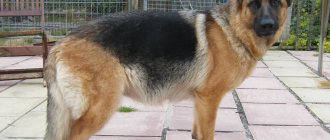
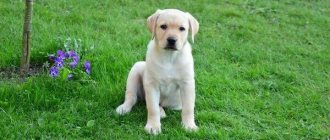
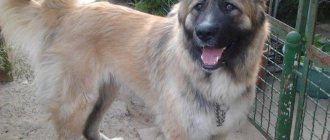


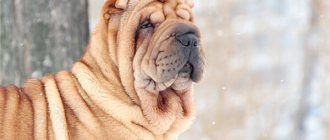

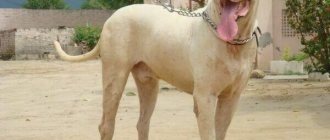
![Weight of a Caucasian Shepherd puppy by month [table]? How to feed](https://loshadka24.ru/wp-content/uploads/ves-shchenka-kavkazskoj-ovcharki-po-mesyacam-tablica-kak-kormit-330x140.jpg)


